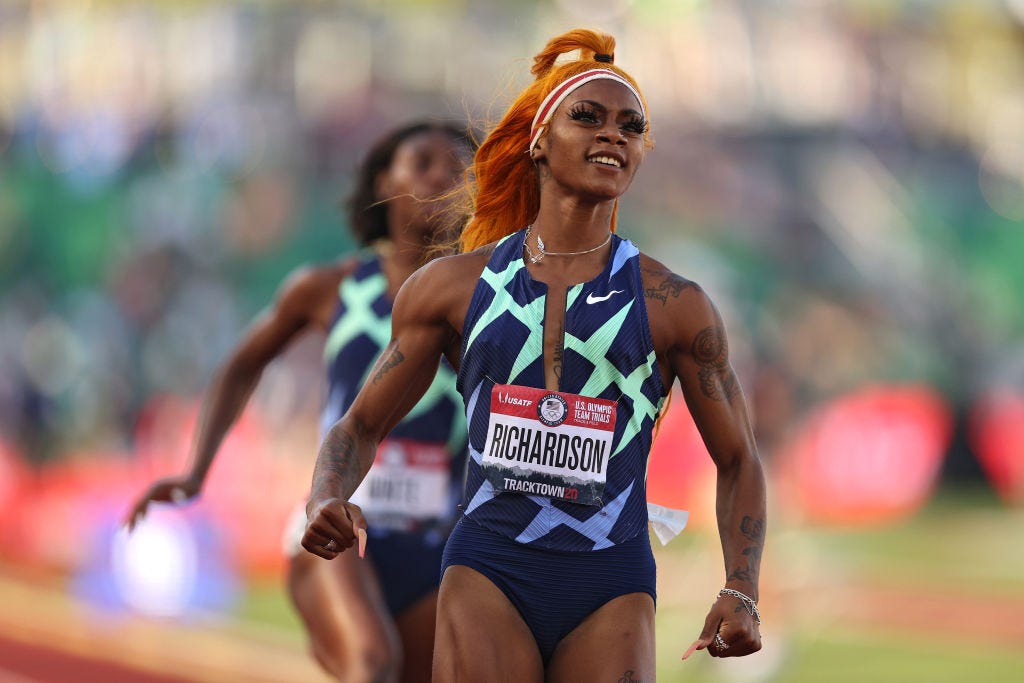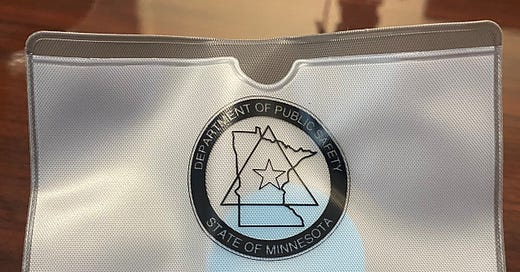The public shaming of Sha'Carri Richardson
It's not about performance, or even fairness. It's about sending a message.

American sprinter Sha’Carri Richardson, a gold metal contender in the upcoming Tokyo Olympics, has been suspended from competition for 30 days following a positive drug test.
The drug in question? Marijuana.
Richardson says that, after recently learning from a reporter that her biological mother had passed away, she used some marijuana to deal with the combination of grief and the pressure of her sudden ascension to the global stage. She did so in Oregon, where the drug is perfectly legal.
For that — for the one-time consumption of a legal, recreational substance that’s used by millions of Americans every single day — Richardson will miss the 100 meter race and have to undergo substance abuse treatment.
Again: for marijuana.
The global anti-doping agency’s stance on marijuana reflects decades of drug war hysteria and misinformation. Marijuana is not — and I can’t stress this enough — a performance-enhancing drug. It quite famously “impairs judgment, motor coordination, and reaction time,” according to the National Institute on Drug Abuse. The entire point of cannabis is that it makes you slow and goofy and giggly — not exactly the mindset elite athletes seek to cultivate during competition.
There’s even been a fair amount of research specifically into how cannabis affects athletic performance. It’s not great research, frankly — ideally you’d want to do something like gather 100 runners, give half of them a weed gummy and half of them a placebo, then wait a bit and see how the two groups perform in a race. But this hasn’t been done, in part because of the byzantine rules around access to pot for research purposes — researchers still, for instance, generally can’t even run tests on the stuff people buy out of legal dispensaries, because federal regs prohibit it.
Still, what we do know is this:
A 2017 review of the existing research — much of it conducted in the 70s and 80s — found that “only 15 published studies have investigated the effects of THC in association with exercise protocols,” and “none showed any improvement in aerobic performance.” Two of them found that marijuana use brought on exhaustion and chest pain more rapidly than placebo. Others showed evidence of decreased strength. One study found that marijuana users perceived exercise to be “harder.”
The last word? “THC does not enhance aerobic exercise or strength.”A 2018 review specifically examined the effects of cannabis on elite athletes. Again, same story: “Cannabis use is more prevalent among some athletes engaged in high-risk sports, but there is no evidence of performance-enhancing or causal effects,” the authors concluded.
In 2019, researchers ran a bunch of exercise tests on two small groups of young men: those who frequently used pot, and those who didn’t. They found “no difference” between the two in terms of lung capacity, aerobic endurance, power output, or strength. There was some evidence that marijuana users fatigued more rapidly during exertions. “In sports where power is important, coaches may want to encourage their athletes to refrain from chronic marijuana use,” the study concludes.
And that’s… basically it. Some musty old research from decades ago, a few more recent reviews of that research, and a trickle of more recent work that fails to find anything of significance. Marijuana is not exactly EPO or human growth hormone and let’s be real: if it were, everyone would be using it.
As it turns out, the anti-doping bodies are wising up to this. In announcing Richardson’s suspension today, the U.S. Anti-Doping Agency had this to say: her cannabis use “occurred out of competition and was unrelated to sport performance” (emphasis added). She was sanctioned, rather, because the doping bureaucracy now classifies marijuana as “a ‘Substance of Abuse’ because it is frequently used in society outside the context of sport.”
Reading between the lines, then, this looks more like a morality clause violation than a strictly anti-doping one: Richardson did a Drug, and Drugs Are Bad. Of note, in the World Anti-Doping Agency’s massive list of prohibited drugs, just four receive the ‘Substance of Abuse’ designation: cocaine, heroin, ecstasy, and weed.
Richardson’s suspension isn’t about performance enhancement, but rather about reinforcing a particular Drug War prohibition, even as that specific prohibition — the one on marijuana — is rapidly disappearing across the globe. This puts it on even shakier logical ground: why is marijuana a substance of abuse but alcohol, unequivocally a far more harmful drug, is not? For that matter why is caffeine — a substance which very clearly does enhance athletic performance — allowed?
Elite athletics’ lack of seriousness when it comes to drug policy is embedded in the very names of the agencies policing that policy: “Anti-Doping,” referring to the rather old-timey slang for “drugs” and the allegedly “dopey” people who use them. The administrative bodies’ language here is deliberate: the World Anti-Doping Agency wasn’t established until 1999. Calling it “doping” is a choice, one intended to shame and stigmatize.
This stigma is at the heart of efforts to police the off-track behavior of athletes like Sha’Carri Richardson. “This is heartbreaking on many levels,” said USADA CEO Travis Tygart using overwrought language straight out of a 1980s anti-pot PSA. “Hopefully, her acceptance of responsibility and apology will be an important example to us all that we can successfully overcome our regrettable decisions.”
It’s not about performance. It’s not about fairness. Rather — to paraphrase Adam Serwer — the shaming is the point.
And that’s your Why Axis for this week. Scheduling note: we’re off next Monday for the Fourth of July. Starting next week some posts will be subscriber-only — sign up if you don’t want to miss anything! And a huge, huge thank you to all of you who already have.











